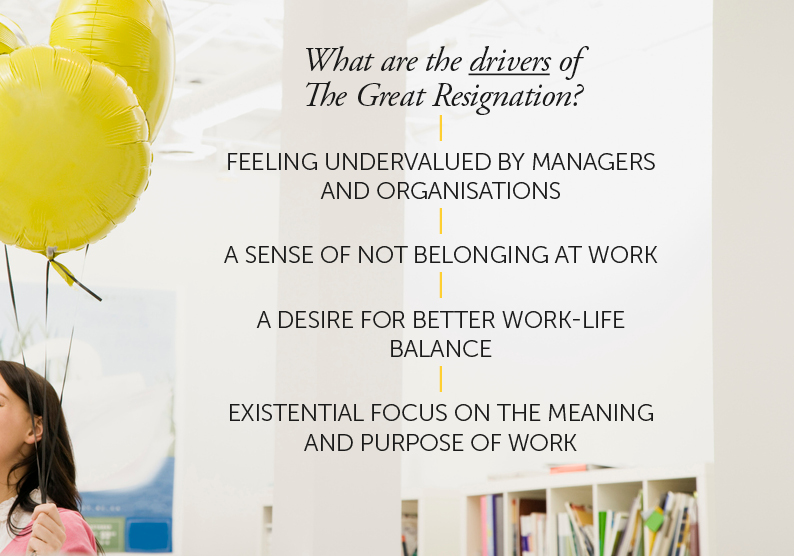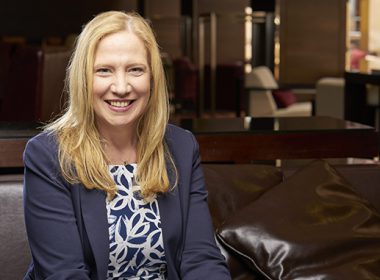High staff turnover is a big problem for many firms, and a post-COVID phenomenon being dubbed "The Great Resignation" is set to make it even more challenging. What can employers do to create an engaging environment that encourages lawyers to stick around for longer?
Employee retention is arguably the most significant HR challenge facing Australian law firms. High staff turnover is expensive and disruptive, and a recent survey by the Australasian Legal Practice Management Association found two-thirds of firms struggle with retention. Turnover rates now average 21 per cent for fee earners and 26 per cent for support roles.
According to experts, the average employee’s tenure is a measly three or four years, with lawyers moving on frequently in pursuit of development opportunities, career progression and flexible working conditions – at every level of seniority.
Hanging on to staff is predicted to become a whole lot more difficult thanks to a pandemic-related phenomenon dubbed “The Great Resignation”, whereby workers around the world are leaving or planning to leave their jobs in record numbers. Research by Microsoft estimates 40 per cent of people in the global workforce are considering leaving their employer this year.
The reasons driving The Great Resignation are many: feeling undervalued by managers and organisations, a sense of not belonging at work, a desire for better work-life balance and, after almost two years of upheaval, an almost existential focus on the meaning and purpose of work.
In the US, where the trend was first identified, resignations rose dramatically in April, and by August 4.3 million workers – nearly three per cent of the entire workforce – had quit their jobs. Likewise, the UK reported a record number of job vacancies (953,000) between May and July. East coast lockdowns and closed borders have delayed The Great Resignation’s arrival in Australia, but early signs suggest it may be just as disruptive.
“Employees have had ample time to consider their lives, and the role work plays in it, over the past 18 months,” says Andrew Brushfield, a director at recruitment firm Robert Half. “There is soaring demand for skilled talent and the expectation of a return to normality, so we do expect rising rates of employee turnover in the coming year as employees become more confident about their prospects in the market.”
So, what can the legal industry, long plagued by demanding, all-encompassing roles and high turnover, do to retain staff and ward off The Great Resignation?
Value matching
For Samantha Murphy, a senior associate at Maddocks, the ability to follow her professional interests, work in different areas of the business and an inclusive, cooperative atmosphere have been key to her seven-year – and counting – association with the firm. It began with a graduate position straight out of university, followed by a stint in dispute resolution and now sees her now working in a public law team with a focus on government and the resources and energy sector.
“I took a year off after high school and worked as a legal assistant in a regional firm, and I kept working for this firm every holiday for my first two or three years of university,” she tells LSJ.
“When I was applying for Maddocks, it stood out to me as having good values of collaboration and valuing their staff – I got the same kind of feeling as my small regional firm. I’ve been very comfortable and at home ever since I started.”
She’s also studying a Master of Environmental Law, with financial support from the firm, and says being able to access both the opportunities and the tools to chart her own career path is an important element of her satisfaction.
Getting that flexible work mix right is really key to being able to retain staff. It might mean flexible working hours, flexible days, the choice of where to work and even things like a flexible dress code as people are now used to rolling out of bed and starting work.
“The people I work with are very supportive of everyone creating their own development plan,” Murphy says. “Being able to take responsibility for your own work gives you motivation and a sense of ownership that ties you to your work – it’s not just work that you’re doing for somebody else.”
Murphy’s experience is no accident, explains Maddocks’ director of people and culture, Deborah Stonley. She says the firm maintains a strong focus on three main areas that their research shows appeals to prospective employees: culture and firm values, career opportunities, and learning and development opportunities.
“All firms are doing these to an extent – it just depends to the degree of where you’re putting your focus. You can use these areas to gain a competitive advantage as they’re difficult to replicate.”
Indeed, in Mercer’s latest benchmarking survey Maddocks ranks fifth out of 51 law firms for the lowest turnover rate, which Stonley says is “in the teens”. “It’s quite a remarkable place to be, as over the years I’ve worked in law firms where it’s sometimes as high as 30 per cent.”
Wellbeing and flexibility
Financial benefits like salaries and bonuses remain key drivers, but employee wellbeing, an area of particular focus throughout the pandemic, will continue to be a significant factor in decisions about whether employees stay or go.
Like many firms, Stonley says Maddocks has implemented a range of initiatives like mental health support sessions, wellbeing days and online exercise classes that help staff strike a healthier balance between work and life.
“Wellbeing surveys have helped us assess the wellbeing of our staff, then put interventions in place to support them.”
For most workers, however, wellbeing is all about flexibility.
“Every single person I’ve spoken to independently about this particular topic says it comes back to one word, and that is flexibility,” says Doron Paluch, director of legal recruitment firm Burgess Paluch.
“Getting that flexible work mix right is really key to being able to retain staff. It might mean flexible working hours, flexible days, the choice of where to work and even things like a flexible dress code as people are now used to rolling out of bed and starting work.”
Louise Watts, a director at training and coaching specialist Transition Hub, agrees that firms must offer flexibility to be competitive.
“We can’t put the genie back in the bottle,” she says. “People want to know that flexibility is there, whether they take it up or not. The statistics are huge.”
Crucially, it’s important to adapt this flexibility to suit employees’ needs – and for many people, demand extends beyond the day-to-day of the tenure itself. Kerryn Underwood has worked for King & Wood Mallesons, on and off, for 21 years.
“I’ve been a solicitor, senior associate and special counsel,” she says. “I started as a solicitor, then I went in-house. I had kids, came back and went in-house again. After that, I took another career break and studied interior design.”
Underwood’s current role as head of legal project management, which she’s held since 2019, is the culmination of the experiences she gained at the firm as well as outside of it.
“It’s been a long and successful relationship,” she says. “They’ve been very accommodating of the things I’ve wanted to do, and it’s given me great opportunities outside the firm with other organisations. Along with the legal work I’d done and the length of time I’ve been with the firm and the contacts I had, when his role came up, it was a was a really good fit.”
Murphy, too, took a one-year leave of absence to take up a litigation role with the NSW government, and says Maddocks’ flexibility was one of the reasons she was keen to return to the firm. “When I made the decision to go back [to private practice], I didn’t really consider many other private firms,” she says. “I figured I’d had such a good experience at Maddocks that going somewhere else just seemed like I would risk getting disappointed because I already knew that I was so happy.”
Focusing on high performers
High staff retention is hugely beneficial, but that’s not to say firms must attempt to retain all staff. Instead, focusing on a core group of high performers is a more effective strategy, says Fionn Bowd, CEO of legal recruitment firm Bowd – not least because this cohort has four times the impact on a firm’s results than lower-performing colleagues.
“Firms should focus on both hiring and retaining the people who are going to be the future of the firm,” she says. “They should be very clear in their minds about who those people are, and then they should be doing everything they can to develop them, grow them, support them, nurture them and bring them along on the journey as part of the future of the firm.
“What happens is sometimes some of the best lawyers get missed in all of the volume as there’s just so much happening in firms. And firms try to treat everybody the same and see who’s still there down the track. That can lead to people who are very good feeling that they’re not valued.”

Watts agrees that employees who feel appreciated and respected are less likely to move on.
“That’s what The Great Resignation is all about,” she says. “It really isn’t about people being unhappy – it’s when no one’s talking to me, I can’t see a future here, and I’ve tried to follow up that person three times and they’re just not making it a priority.”
She says ongoing career conversations will aid retention of high performers: “People want to be able to sit down and talk about their ambition without being seen as someone who’s trying to get ahead of themselves.”
As the most important relationship most lawyers will cultivate and respect in a firm, partners have a key role in this dialogue.
“If you know your partner knows you, cares about you and takes an interest in you as a person and the work that you’re doing, that’s what keeps your people engaged and connected,” Stonley says. “When they get those phone calls from recruiters or other law firms, they listen to the call, but they’re not tempted by it because of that connection they have.”
Indeed, Underwood says a solid relationship with a partner is one of the main reasons she returned to her firm – over and over again.
“I was really lucky because I had a partner who wanted me to stay and knew that I was thinking about exploring other options, so really made an effort to make sure I was aware of what was coming up and opportunities that might be arising.”
A different kind of carrot
What of the “tournament” system that encourages lawyers to stay with a firm and compete for the limited, distant prize of partnership? Perhaps unsurprisingly, for many lawyers its appeal is fading.
“We get a lot of lawyers who remain at a law firm because they’ve been promised that they’ll be looked at over the next one to two years,” Paluch says. “We also speak to a lot of senior lawyers who are frustrated because of those undertakings made by a law firm that are not delivered.”
Bowd says younger generations have many more employment options and see no need to wait for the promise of partnership, while older lawyers are increasingly questioning whether it’s an arrangement worth buying into.
“The model of that being the only way that you can work, that is job security now and partnership incentive later, is dead. People are no longer prepared to put in the years for a distant payoff that may never come,” Bowd says.
Instead, she proposes a radical shake-up of remuneration structures to encourage retention.
“Paying lawyers salaries isn’t going to work anymore. They’re going to have to be paid for the work that they do, for the income that they generate, based on their time.”
She recommends a minimum salary plus an hourly rate for time worked: “We need to bring that revenue sharing forward and start sharing it with people. Maybe not from day one, but probably from year three we need to start revenue sharing so people get paid for the work that they do, rather than expecting them to hang out until they’re partners to get it back.”




